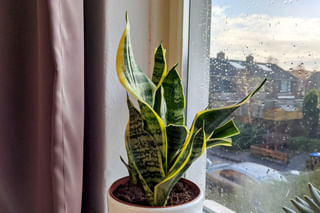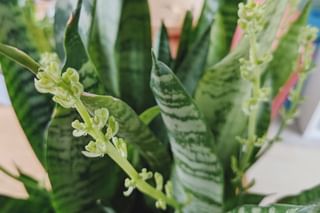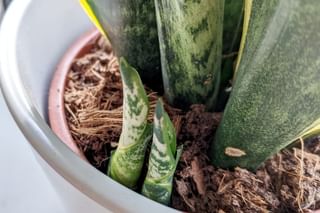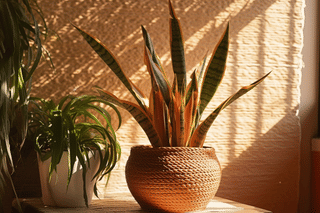How to care for Sansevierias
One of the easiest types of plant for beginners is a plant in the Sansevieria family. They require very little attention, they purify the air in your house and they look amazing. In this guide, we'll go over everything you need to know when you're taking care of a Sansevieria.
 Some of the easiest types of plants for beginners is a plant in the Sansevieria family. They require very little attention, they purify the air in your house, and they look amazing. Even though they are very easy to take care of there are a few things you need to keep in mind when taking care of this plant, but especially the water requirements and the light levels.
Some of the easiest types of plants for beginners is a plant in the Sansevieria family. They require very little attention, they purify the air in your house, and they look amazing. Even though they are very easy to take care of there are a few things you need to keep in mind when taking care of this plant, but especially the water requirements and the light levels.
These are the steps we're going to cover in this guide:
Let's learn more about taking care of a Sansevieria!
Water requirements
Sansevierias are plants that need very little water. They are tough plants that thrive in most indoor conditions. When it comes to watering your Sansevieria, the best approach is to allow the soil to dry out completely between watering sessions. Depending on the temperature and humidity of your living spaces, this may mean watering your plant every two to eight weeks.
To find out whether your Sansevieria needs watering, you can check the soil moisture level with a moisture meter or by sticking your finger into the soil. If the soil feels dry, it's time to water your plant. However, if the soil feels damp or moist, it's best to wait to water for a few more days.
Sensitive to overwatering
It's important not to overwater your Sansevieria, as this can lead to root rot and the possible death of your plant. In general, it's better to underwater than overwater your Sansevieria.
If you kill this plant, it's most likely due to overwatering. So make sure you put this plant in very well-draining soil and when you water it, make sure none of the excess water stays in the pot. Sansevierias can't have their roots in any water, because root rot occurs quite easily. Sansevierias are very sensitive to overwatering and prefer to be dry most of the time.
This all sounds very scary, but it isn't. Just forget to water this plant for 2 to 4 weeks at a time and you'll be fine. I've once forgotten to water my snake plant for 2 months and it thrived during this period. The plant loved the lack of moisture! It never suffered from this and it was happy to get water again after that long period of drought.
In the summer you can water this plant every two weeks, but in the winter, when it's dormant, limit this to once a month. This depends on where you place your Sansevieria: in a bright or dark location. If it's in a brighter location, you can water it a little more often. Just make sure the soil dries out in between waterings.
Light requirements

A great place for the Sansevieria is near a north or east-facing window, which provides gentle morning light, or further away from a south or west-facing window that receives intense afternoon light.
Sansevierias can tolerate low light conditions, which is great if you've got dark spots in your house. I've had my snake plant in the shade for at least 6 months now and it still looks just as beautiful as when I first got it. It won't grow as quickly as when you provide it with some more light, but if you're okay with this, it's not a problem to keep this plant in a darker place.
A sansevieria is a very strong plant, when you expose it to direct sunlight from a southern/western window, its leaves won't burn. However, when you do place your plant in an environment like this, make sure to water it more often, as water evaporates much quicker in direct sunlight. When your Sansevieria gets more sunlight, it'll also grow much more quickly.
Temperature requirements
While they thrive in warm environments, they can still tolerate low temperatures, making them an excellent option for those who live in colder climates.
Ideally, sansevierias should be kept at temperatures ranging from 15 to 29 degrees Celsius (60 to 85 F). However, they can withstand temperatures as low as 10 degrees Celsius (50 F) for short periods. However, it's important to know that long exposure to temperatures below 10 C can damage the plant and cause leaves to turn yellow.
If you live in an area where temperatures can dip below 10 degrees Celsius (50 F), it's best to keep your sansevieria indoors during the winter. You can place them near a sunny window where they can still receive adequate light and warmth. If your home's heating system is not on the warmer side, you can also use a heat mat or a small space heater to keep the plant cozy.
Fertilizing your Sansevieria
If you don't like to fertilize your plants, a Sansevieria is the perfect plant for you. Sansevierias are slow-growing plants, so it's not necessary to fertilize them. Fertilizing is usually reserved for plants that grow quickly, have flowers, or use a lot of energy in another way.
While they can survive without fertilization, adding fertilizer to your Sansevierias can speed up their growth and overall health, if that's what you're looking for with your plants.
Sansevierias don't have flowers, don't grow quickly, and are generally very static plants. They're incredibly energy efficient, and won't require fertilizer very often. If you do want to use fertilizer, use it during the growing season (spring and summer) and use general plant fertilizer.
You can use a balanced houseplant fertilizer, such as a 20-20-20 blend, to provide the nutrients your Sansevierias need. When fertilizing your Sansevierias, be sure to dilute the fertilizer with water according to the instructions on the label of your fertilizer and apply it to the soil rather than to the leaves. Over-fertilizing your Sansevierias can lead to burnt roots and leaves, so it's important to be careful when fertilizing.
Soil for sansevierias
Sansevierias are plants that love dry environments and don't do well in humid and wet environments. Because of this, it's important to use very well-draining soil for sansevierias. It's best to combine this with a pot that has a drainage hole in the bottom. This way all the excess water will escape from the pot and you won't risk your sansevieria getting root rot.
The ideal soil is well-draining and slightly acidic. This means that the soil should be able to get rid of excess water quickly, but still retain enough moisture for the plant's roots to absorb. A good rule of thumb is to use a soil mix that is designed for succulent plants, which is typically a blend of sand, perlite, and peat moss.
You can also grow your Sansevierias in Leca as this is perfect for plants that like to dry out and are sensitive to overwatering. Leca will take away all the difficulty when it comes to soil and watering your Sansevieria properly. The only thing you'll have to think about with Leca is the sunlight exposure, which makes this plant even easier to take care of.
It's also important to realize that Sansevierias don't need to be repotted often, as they prefer to be a bit root-bound. When you do repot, make sure to use a pot that is only slightly larger than the one your plant is currently in. This will help to prevent overwatering and keep your Sansevierias healthy and thriving!
Propagating your Sansevieria
If you want to propagate your Sansevieria to create even more thriving beauties, there are a few methods you can try out.
-
Division: One of the easiest ways to propagate Sansevierias is through division. Simply remove the plant from its pot and gently separate the roots into smaller sections, making sure each section has some leaves and roots attached. Replant the smaller sections in fresh soil and water well.
-
Leaf cuttings: Another method is through leaf cuttings. Cut a healthy leaf from the mother plant and allow it to sit for a day or two to callus over. Plant the leaf cuttings in moist potting soil and water sparingly until new shoots appear.
Be patient when propagating your snake plants as it can take several weeks to see new growth.
Repotting your Sansevieria
Sansevierias are very tough and can survive through neglect. However, for optimal growth and health, repotting is necessary every once in a while. How often you should repot your plant depends on a few things, including the size of the plant, the size of the pot, and how quickly it has been growing. As a general guideline, you should repot your Sansevieria every 2-3 years.
If you notice roots growing out of the drainage holes or the plant is top-heavy and leaning over, it's a sign that it needs a new home.
When repotting, choose a container that is slightly larger than the current pot. Use a well-draining soil mix, and make sure that the roots are not damaged during the transplant process.
After you've repotted the sansevieria, water it thoroughly to help the soil settle around the plant's roots. Repotting is an important aspect of Sansevieria care and helps to promote healthy growth and ensure that your plant thrives for years to come.
Grooming and pruning practices
Sansevierias are low-maintenance houseplants that are great for beginners. Even though these plants are very tough, pruning and grooming practices can help to keep your plant healthy long-term.
First, it is important to remove any dead or damaged leaves as they can attract pests and diseases. This can be done by gently pulling the leaf downwards until it snaps off from the base. If that doesn't work, use a sharp knife or scissors.
If the plant becomes overcrowded, you might need to start thinking about dividing the Sansevieria. This can be done by carefully digging up the plant and separating the root system into smaller sections as we've already learned in the section about propagation.
While Sansevierias do not need to be watered very often, it is important to keep their leaves clean as they can get dusty. Wiping the leaves with a damp cloth once a month can help prevent pest infestations and keep your plant looking fresh.
Flowers on your Sansevieria

It's also important to check if your house plant has enough space to keep growing or if it might be time to repot. These flowers are a bad sign, but they don't harm your plant in any way.
Common pests and diseases
Sansevierias, no matter how tough they are, can be attacked by pests and diseases, just like any other plant.
One of the most common pests that affect Sansevierias is spider mites. These tiny insects can cause damage by sucking the sap from the leaves, leading to discolored and dry foliage. To prevent spider mites, it's crucial to keep the air around the plant humid. You can also wipe down the leaves regularly with a damp cloth to keep them clean.
Another pest to watch out for is mealybugs. These appear as white, fluffy patches on the leaves of the plant. They feed on the sap of the plant, which can cause leaves to become yellow and distorted. To prevent mealybugs, you can use insecticidal soap sprays or wipe them off with a damp cloth.
Root rot is another common issue that Sansevieria plants can face. This occurs when the roots sit in waterlogged soil, causing them to decay. To prevent root rot, make sure to use well-draining soil, and avoid overwatering.
Keeping Sansevierias pest and disease-free can take a little bit of effort, but it's much easier than most other plants. Keeping the air humid, wiping down the leaves, using insecticidal soap sprays, and avoiding overwatering can help keep these plants healthy and beautiful.
Conclusion
Sansevierias are very strong and beautiful plants. They can grow in low-light environments, but also in direct sunlight. The most important thing to keep in mind when taking care of a Sansevieria is to keep it in a dry environment.
Sansevierias are very sensitive to overwatering, so keeping them in a dry environment is vital for them to thrive. If you're unsure whether you can water a Sansevieria correctly, you can always grow this amazing plant in Leca.
Thank you for reading this post! I hope it helps you to keep your plants healthy and beautiful! If you're looking for more guides on specific plants, you can always request a plant guide to get a guide for the plant you have trouble with.
Test your plant care knowledge
Quiz completed!
Want to learn more? Sign up for my newsletter to receive free tips in your inbox!
Sign up now!












